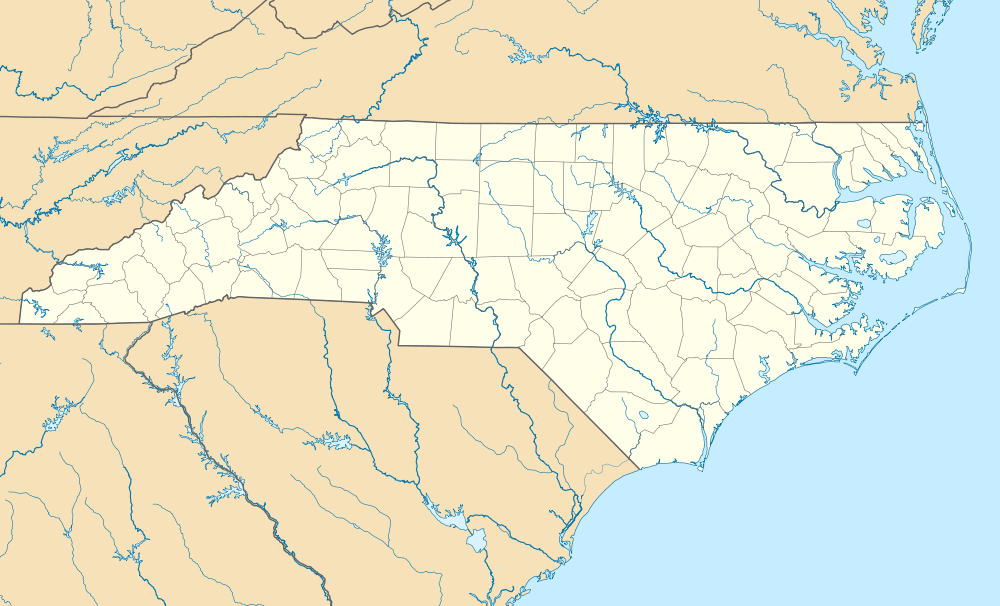Downtown Asheville Historic District
Downtown Asheville Historic District is a national historic district located at Asheville, Buncombe County, North Carolina. The district encompasses about 279 contributing buildings and 1 contributing objects in the central business district of Asheville. It includes commercial, institutional, and residential buildings in a variety of popular architectural styles including Colonial Revival, Queen Anne, and Art Deco.[2][3]
Downtown Asheville Historic District | |
 Asheville Downtown panorama, September 2012 | |
  | |
| Location | Roughly bounded by 1240 Valley St., Hilliard Ave., and Broad Ave.; also 60 and 64 Biltmore Ave.; also Church St. and Ravenscroft Dr.; also 76-129 Biltmore Ave., 64 Carter St., 11-23 Grove St., 14-44 N. French Broad Ave., 12-25 S. French Broad Ave.; Asheville, North Carolina |
|---|---|
| Coordinates | 35°35′42″N 82°33′12″W |
| Area | 96.35 acres (38.99 ha) |
| Architect | Multiple |
| Architectural style | Late 19th And Early 20th Century American Movements, Late 19th And 20th Century Revivals, Colonial Revival, Bungalow/craftsman, Queen Anne, Art Deco, Chicago, Commercial Style |
| MPS | Asheville Historic and Architectural MRA |
| NRHP reference No. | 79001676, 89000468 (Boundary Increase), 90001342 (Boundary Increase)[1] |
| Added to NRHP | April 26, 1979, May 25, 1989 (Boundary Increase), August 23, 1990 (Boundary Increase), December 28, 2011 (increase-and-decrease) |
Located in the district and listed separately are the Asheville City Hall, Buncombe County Courthouse, Thomas Wolfe House, Young Men's Institute Building, Ravenscroft School, Church of St. Lawrence, Battery Park Hotel, S & W Cafeteria, and the Arcade Building. Other notable buildings include the Flatiron Building (1927), Drhumor Building (1895), Sondley Building (1891), Grand Central Hotel Annex (c. 1886), Public Service Building (1929), Kress Building (1926-1927), Mount Zion Missionary Baptist Church (1919), First Church of Christ Scientist (1900-1912), U. S. Post Office and Courthouse (1929-1930), Asheville Citizen and Times Building (1938-1939), Former Bon Marche Department Store (1923), Castanea Building (1921), Loughran Building (1923), Central Methodist Church (1902-1905, 1924, 1968), Trinity Episcopal Church (1912), First Presbyterian Church (1884-1885), Eagles Home (1914), Scottish Rite Cathedral and Masonic Temple (1913), and the Jackson Building (1923-1924).[2]
It was listed on the National Register of Historic Places in 1979, with boundary increases in 1989 and 1990.[1] An increase / decrease occurred in 2011.
References
- "National Register Information System". National Register of Historic Places. National Park Service. July 9, 2010.
- David R. Black (n.d.). "Downtown Asheville Historic District" (pdf). National Register of Historic Places - Nomination and Inventory. North Carolina State Historic Preservation Office. Retrieved 2014-08-01.
- Clay Griffith (August 2011). "Downtown Asheville Historic District (Boundary Increase III, Boundary Decrease & Additional Documentation)" (pdf). National Register of Historic Places - Nomination and Inventory. North Carolina State Historic Preservation Office. Retrieved 2014-08-01.

